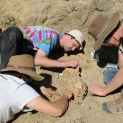Scientists at The Mammoth Site conduct research on an interesting find
Photo courtesy of The Mammoth Site.
A mammoth skull discovered last year in the Channel Islands, off the California coast has made it to The Mammoth Site in Hot Springs. Black Hills FOX's Jon Wilson saw the skull Wednesday and spoke with members of the team seeking to learn more about the extinct animal.
Last year, a small piece of tusk was discovered by a National Park Service Intern in Channel Island National Park off the coast of California. After excavation, that small piece was just part of a find that proved to be better than expected. It turned out that a whole mammoth skull was intact.
Bonebed Curator at The Mammoth Site Justin Wilkins says, "Even a chunk would've been a prize specimen to study. So we then convinced the park that this was important. We did all the safety and logistics planning to make sure that we could take this out safely, and in a way that was appropriate for the park."
The mammoth skull arrived in South Dakota a couple months ago, and research is ongoing.
Chief Scientist at The Mammoth Site Jim Mead says, "This particular project is a collaboration between The National Park Service, Channel Islands National Park, Santa Barbara Museum of Natural History in Santa Barbara, and then us.
Fossil Preparator at The Mammoth Site Monica Bugbee says, "This is kind of the front of his face. In the center, you have his nose, so this is the nasal cavity, nasal passages, and this is where the trunk would come out of the front of the mammoth and go down in between the tusks. On the side of this area, there's two, kind of indented spaces, and that's where his eyes would be. Those are the eye orbits. And then down from that, these are the tusk sockets, which is kind of a long part in the front of the face, and then the tusks fit in from the bottom of that and curve down and around."
This is no ordinary find either, and experts are confused by the size of this mammoth.
Bugbee says, "On the islands, you have a Colombian Mammoth, which is the same type we have at The Mammoth Site here, and those are the really big guys that can be twelve, thirteen feet tall at the shoulders. On the islands, you also have another species that's called the Pygmy Mammoth, which is about six feet tall at the shoulders. This guy tends to fall out in the middle of that, and we're not sure what that means yet. It could possibly be a transitional animal that's somewhere on that evolutionary line."
While they do not know the exact species, they do know a couple important things. Through radiocarbon dating, they have determined it died roughly 13,400 years ago, and that this mammoth was a middle age male. The team will learn more each and every day as they continue to unearth this large specimen.
Mead says, "Ultimately, our project is to do the research on it. Find out what is it telling us about the evolution of mammoths when a large mammoth gets to an island, how long does it take for it to become as a herd, to become a smaller individual? How many generations is that? We need to describe the animal. What species might it be? We're going to look at the DNA."
Including pay for employees on the site, Mead estimates a total cost of $50,000 to excavate the skull, ship it from the island to land, and then transport it to Hot Springs. When the research is complete, the skull will be transported back to Channel Islands National Park where they decide what to do with the piece of history from there.
To read the full article, click here.


